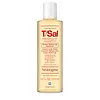What's inside
What's inside
 Key Ingredients
Key Ingredients

 Benefits
Benefits

 Concerns
Concerns

 Ingredients Side-by-side
Ingredients Side-by-side

Salicylic Acid 3%
MaskingWater
Skin ConditioningAmmonium Laureth Sulfate
CleansingAmmonium Lauryl Sulfate
CleansingPEG-10 Sunflower Glycerides
EmollientSodium Methyl Cocoyl Taurate
CleansingCocamidopropyl Betaine
CleansingParfum
MaskingCocodimonium Hydroxypropyl Hydrolyzed Rice Protein
Skin ConditioningChamomilla Recutita Flower Extract
MaskingLavandula Angustifolia Extract
Skin ConditioningRosmarinus Officinalis Leaf Extract
AntimicrobialAcacia Farnesiana Flower Extract
PerfumingTocopheryl Acetate
AntioxidantAloe Barbadensis Leaf Juice
Skin ConditioningPanthenol
Skin ConditioningCocamide Mea
EmulsifyingSodium Lauryl Glucose Carboxylate
CleansingBenzyl Alcohol
PerfumingLauryl Glucoside
CleansingPolyquaternium-67
Linoleamidopropyl Pg-Dimonium Chloride Phosphate
Potassium Hydroxide
BufferingCitric Acid
BufferingDisodium EDTA
Benzophenone-4
UV AbsorberIsopropyl Myristate
EmollientPropylene Glycol
HumectantSalicylic Acid 3%, Water, Ammonium Laureth Sulfate, Ammonium Lauryl Sulfate, PEG-10 Sunflower Glycerides, Sodium Methyl Cocoyl Taurate, Cocamidopropyl Betaine, Parfum, Cocodimonium Hydroxypropyl Hydrolyzed Rice Protein, Chamomilla Recutita Flower Extract, Lavandula Angustifolia Extract, Rosmarinus Officinalis Leaf Extract, Acacia Farnesiana Flower Extract, Tocopheryl Acetate, Aloe Barbadensis Leaf Juice, Panthenol, Cocamide Mea, Sodium Lauryl Glucose Carboxylate, Benzyl Alcohol, Lauryl Glucoside, Polyquaternium-67, Linoleamidopropyl Pg-Dimonium Chloride Phosphate, Potassium Hydroxide, Citric Acid, Disodium EDTA, Benzophenone-4, Isopropyl Myristate, Propylene Glycol
 Reviews
Reviews

Ingredients Explained
These ingredients are found in both products.
Ingredients higher up in an ingredient list are typically present in a larger amount.
Citric Acid is an alpha hydroxy acid (AHA) naturally found in citrus fruits like oranges, lemons, and limes.
Like other AHAs, citric acid can exfoliate skin by breaking down the bonds that hold dead skin cells together. This helps reveal smoother and brighter skin underneath.
However, this exfoliating effect only happens at high concentrations (20%) which can be hard to find in cosmetic products.
Due to this, citric acid is usually included in small amounts as a pH adjuster. This helps keep products slightly more acidic and compatible with skin's natural pH.
In skincare formulas, citric acid can:
While it can provide some skin benefits, research shows lactic acid and glycolic acid are generally more effective and less irritating exfoliants.
Most citric acid used in skincare today is made by fermenting sugars (usually from molasses). This synthetic version is identical to the natural citrus form but easier to stabilize and use in formulations.
Read more about some other popular AHA's here:
Learn more about Citric AcidCocamidopropyl Betaine is a fatty acid created by mixing similar compounds in coconut oil and dimethylaminopropylamine, a compound with two amino groups.
This ingredient is a surfactant and cleanser. It helps gather the dirt, pollutants, and other impurities in your skin to be washed away. It also helps thicken a product and make the texture more creamy.
Being created from coconut oil means Cocamidopropyl Betaine is hydrating for the skin.
While Cocamidopropyl Betaine was believed to be an allergen, a study from 2012 disproved this. It found two compounds in unpure Cocamidopropyl Betaine to be the irritants: aminoamide and 3-dimethylaminopropylamine. High-grade and pure Cocamidopropyl Betaine did not induce allergic reactions during this study.
Learn more about Cocamidopropyl BetaineWe don't have a description for Linoleamidopropyl Pg-Dimonium Chloride Phosphate yet.
Salicylic Acid (also known as beta hydroxy acid or BHA) is a well-known ingredient for treating skin that struggles with acne and clogged pores. It exfoliates both the skin's surface and deep within the pores to help clear out buildup, control oil, and reduce inflammation.
Unlike AHAs (alpha hydroxy acids), salicylic acid is oil-soluble. This allows it to penetrate into pores which makes it especially effective for treating blackheads and preventing future breakouts.
Salicylic acid is also known for its soothing properties. It has a similar structure to aspirin and can calm inflamed or irritated skin, making it a good option for acne-prone skin that is also sensitive.
Concentrations of 0.5-2% are recognized by the U.S. FDA as an over-the-counter topical acne product.
It can cause irritation and/or dryness if one's skin already has a compromised moisture barrier, so it's best to focus on repairing that before introducing this ingredient into your routine.
While salicylic acid does not increase sun sensitivity, it’s still important to wear sunscreen daily to protect your skin.
If you are looking for the ingredient called BHA or Butylated Hydroxyanisole, click here.
Learn more about Salicylic AcidWater. It's the most common cosmetic ingredient of all. You'll usually see it at the top of ingredient lists, meaning that it makes up the largest part of the product.
So why is it so popular? Water most often acts as a solvent - this means that it helps dissolve other ingredients into the formulation.
You'll also recognize water as that liquid we all need to stay alive. If you see this, drink a glass of water. Stay hydrated!
Learn more about Water